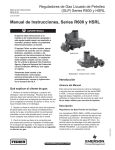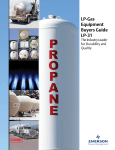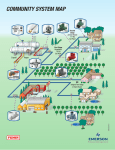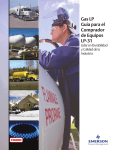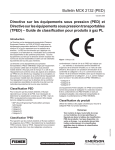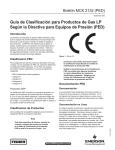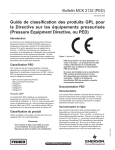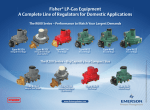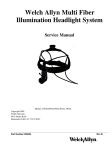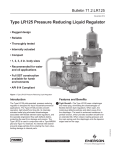Download Emerson HSRL Series Second-Stage Regulator Instruction Manual
Transcript
Instruction Manual MCK 2141 R600 and HSRL Series LP-Gas Regulators February 2013 R600 and HSRL Series Instruction Manual ! WARNING Failure to follow these instructions or to properly install and maintain this equipment could result in an explosion and/or fire causing property damage and personal injury or death. Fisher® equipment must be installed, operated, and maintained in accordance with federal, state, and local codes and Fisher instructions. The installation in most states must also comply with NFPA No. 54 and 58 standards. TYPE R622 Only personnel trained in the proper procedures, codes, standards, and regulations of the LP-Gas industry should install and service this equipment. TYPE R642 Things to tell the gas customer: 2. Show the customer the shutoff valve on the container. The customer should close this valve immediately if gas is smelled, appliance pilot lights fail to stay on or appear higher than usual or any other abnormal situation occurs. 3. Tell the customer to call your company to service the regulator if the regulator vents gas or a leak develops in the system. Only a qualified gas service person should install or service the regulator. Introduction Scope of the Manual This Instruction Manual covers Installation and Maintenance for the R600 and HSRL Series regulators, which includes first stage, second stage, two psig service, integral two- stage and integral two psig service regulators TYPE HSRL Figure 1. Types R622, R642, and HSRL Series Regulators used on LP-Gas vapor service applications. They are not to be used on liquid service. Description First Stage and 2 psig / 0.14 bar Service Regulators The Types R622H, R622E, and R652E regulators are designed for high pressure (pounds per square inch) vapor service. These regulators have high capacity internal relief valves. When used on first stage service, the Type R622H regulator reduces container pressure to 10 psig / 0.69 bar for a second stage regulator. On final stage service the www.fisherregulators.com D450133T012 1. Show the customer the vent or vent assembly or vent tube. Stress that this opening must remain unobstructed at all times. Tell the customer to check the vent opening after a freezing rain, sleet storm, or snow to make sure ice has not formed in the vent. R600 and HSRL Series LP-Gas Regulators Specifications Specifications section, Tables 1 and 2 list the specifications for these regulators. Contact the factory if the regulator is to be used on any service other than LP-Gas, natural gas, or air. The following information is located on the spring case: Type number, orifice size, spring range, and date of manufacture. Pressure Taps Size Restriction R600 Series: 1/8 NPT: #54 (0.055 inch / 1.40 mm) Drill on outlet and inlet HSRL Series: None Orifice Sizes R600 Series (Except R632A and R632E Series): 7/32 inch / 5.6 mm R632A and R632E Series: 0.256 inch / 6.5 mm HSRL Series: 3/8 inch / 9.5 mm Wide-open Cg for Relief Sizing R600 Series: 38 HSRL Series: 105 Maximum Allowable Inlet Pressure(1) Types R622H, R632A, and R632E: 250 psig / 17.2 bar Types R622E and R652E: 10 psig / 0.69 bar Types R622, R642, R652, and HSRL Series: 10 psig / 0.69 bar Maximum Emergency Inlet Pressure(1) Types R622H, R632A, and R632E: 250 psig / 17.2 bar Types R622E and R652E: 15 psig / 1.0 bar Types R622, R642, R652, and HSRL Series: 15 psig / 1.0 bar Temperature Capabilities(1) R600 and HSRL Series: -20 to 160ºF / -29 to 71ºC(2) Pressure Registration Internal Outlet Pressure Standard Setpoint Types R622, R642, R652, and HSRL Series: 11 inches w.c. / 27 mbar Type R632A: First Stage: approximately 8 psig / 0.55 bar at 75 psig / 5.2 bar, 65 SCFH / 1.84 Sm3/h Second Stage: 11 inches w.c. / 27 mbar Outlet Pressure Standard Setpoint (continued) Type R632E: First Stage: approximately 8 psig / 0.55 bar at 75 psig / 5.2 bar, 65 SCFH / 1.84 Sm3/h Second Stage: 2 psig / 0.14 bar Types R622E and R652E: 2 psig / 0.14 bar Type R622H: 10 psig / 0.69 bar, 5 psig / 0.35 bar Outlet Pressure Spring Range Types R622, R642, and R652: 7.5 to 9.5 inches w.c. / 19 to 24 mbar, 9 to 13 inches w.c. / 22 to 32 mbar, 13 to 20 inches w.c. / 32 to 50 mbar, 16 to 40 inches w.c. / 40 to 99 mbar Type R632A: First Stage: non-adjustable Second Stage: 9 to 13 inches w.c. / 22 to 32 mbar Type R632E: First Stage: non-adjustable Second Stage: 1 to 2.2 psig / 69 mbar to 0.15 bar Types R622E and R652E: 1 to 2.2 psig / 69 mbar to 0.15 bar Type R622H: 8 to 12 psig / 0.55 to 0.83 bar, 4 to 6 psig / 0.28 to 0.41 bar HSRL Series: 9 to 13 inches w.c. / 22 to 32 mbar Approximate Weight Type R622H with POL Inlet: 1.7 pounds / 771 grams Types R632A and R632E with POL inlet: 2.9 pounds / 1310 grams Types R632A and R632E with NPT Inlet: 2.5 pounds / 1125 grams All Other R600 Series: 1.4 pounds / 635 grams HSRL Series: 4.5 pounds / 2.0 kg 1. The pressure/temperature limits in this Instruction Manual or any applicable standard limitation should not be exceeded. 2. Product has passed Fisher® testing for lockup, relief start-to-discharge and reseal down to -40ºF / -40ºC. regulator reduces container pressure for a high pressure burner. The regulator is normally painted RED. Second Stage Low Pressure Regulators The Type R622E or R652E standard outlet pressure setting is 2 psig / 0.14 bar. The regulator is painted PALM GREEN with a WHITE CAP. It is an intermediate stage regulator that reduces 10 psig / 0.69 bar first stage pressure to 2 psig / 0.14 bar. They are used on 2 psig / 0.14 bar pressure systems. The Types R622E and R652E are not suitable for first stage service. The Types R622, R642, R652, and HSRL Series regulators provide low pressure, inches of water column, delivery pressures. They are normally set at 11-inches w.c. / 27 mbar pressure. They have high capacity internal relief valve construction. The regulators are normally painted PALM GREEN. The units differ in construction and capacity rating. 2 R600 and HSRL Series LP-Gas Regulators Integral Two-stage Regulator The Type R632A integral two-stage regulator contains a non-adjustable first stage regulator on the inlet. The second stage provides 11-inches w.c. / 27 mbar outlet pressure. The second stage portion has a high capacity internal relief valve construction. The first stage does not have an internal relief valve. The regulators are normally painted GRAY with a BLACK CAP. VENT POINTED DOWN Integral Two psig Service Regulator The Type R632E integral two psig service regulator contains a non-adjustable first stage regulator on the inlet. The second stage provides 2 psig / 0.14 bar outlet pressure. The second stage portion has a high capacity internal relief valve construction. The first stage does not have an internal relief valve. The regulators are normally painted GRAY with a WHITE CAP and White 2-psig STICKER. 3 FEET / 0.913meter T14446-A2 Figure 2. Regulator with Vent Pointed Down Installation ! accumulation of gas which could result in personal injury or property damage. WARNING Never use a Type R622H, R622E, R632E, or R652E (pounds-to-pounds) regulator on low pressure (inches of water column) service because personal injury or property damage could occur. The Types R622E and R652E are not suitable for use as a “first stage” regulator. All vents should be kept open to permit free flow of air in and out of the regulator. Protect vent openings against the entrance of rain, snow, ice formation, paint, mud, insects, or any other foreign material that could plug the vent or vent line. LP-Gas may discharge to the atmosphere through the vent. An obstructed vent which limits air or gas flow can cause abnormally high pressure that could result in personal injury or property damage. Failure to use a vent line on Indoor Installations can cause a hazardous General Installation Instructions Before installing the regulator, • Check for damage, which might have occurred in shipment. • Check for and remove any dirt or foreign material, which may have accumulated in the regulator body. Table 1. Relief Valve Specifications TYPE TYPICAL SETPOINT psig bar NOMINAL RELIEF VALVE START-TO-DISCHARGE psig bar MAXIMUM INLET PRESSURE TO NOT EXCEED OUTLET PRESSURE WITH DISC REMOVED Inlet Pressure Maximum Outlet Pressure psig bar 15 1.0 50 3.4 R632A(1) 250 17.2 R632E(1) 250 17.2 50 3.4 HSRL R622 and R642 11 inches w.c. 27 mbar 1 69 mbar psig bar 2 0.14 5 0.34 R652 R622E 2 0.14 3.5 0.24 10 0.69 20 1.37 R652E R622H Not Applicable 1. For integral two-stage regulators, the second stage disc is removed. 3 R600 and HSRL Series LP-Gas Regulators Table 2. Capacity, Connection Sizes, and Vent Orientation REGULATOR APPLICATION TYPE NUMBER CAPACITY BTU/HR PROPANE(1) INLET CONNECTION OUTLET CONNECTION R622-BCF 875,000 1/2-inch FNPT 1/2-inch FNPT R642-DFF 900,000 R652-DFF 1,000,000 3/4-inch FNPT 3/4-inch FNPT R622-CFF Second Stage OUTLET PRESSURE SETTING 11 inches w.c. / 27 mbar 1/2-inch FNPT 1,400,000 R622-DFF R622-CFGXA Over Inlet 3/4-inch FNPT 1,125,000 HSRL-BFC(2) HSRL-CFC(2) 3/4-inch FNPT 18 inches w.c. / 45 mbar 1-inch FNPT 11 inches w.c. / 27 mbar 1/2-inch FNPT 3/4-inch FNPT 2,100,000 1-inch FNPT R632A-BCF 1/4-inch FNPT 850,000 1/2-inch FNPT R632A-HCF FPOL R632A-CFF 950,000 1/4-inch FNPT R632A-JFF 850,000 FPOL 11 inches w.c. / 27 mbar 3/4-inch FNPT Integral Two-Stage R632A-BCFXA 1/4-inch FNPT 850,000 1/2-inch FNPT R632A-HCFXA Integral 2 psig / 0.14 bar Service FPOL R632A-CFFXA 950,000 1/4-inch FNPT R632A-JFFXA 850,000 FPOL R632E-BCH 850,000 1/4-inch FNPT R632E-HCH 900,000 FPOL 11 inches w.c / 27 mbar First Stage(3): Down Second Stage: Over Outlet First Stage(3): Opposite gauge taps 3/4-inch FNPT Second Stage: Opposite gauge taps 1/2-inch FNPT First Stage(3): Down 2 psig / 0.14 bar R632E-CFH 1/4-inch FNPT 850,000 Second Stage: Over Outlet 3/4-inch FNPT R632E-JFH 2 psig / 0.14 bar Service 3/4-INCH NPT SCREENED VENT STANDARD LOCATION FPOL R622E-BCH 1,250,000 R622E-DCH 1,500,000 R652E-DFH 1,400,000 R622H-BGK 2,000,000 1/2-inch FNPT 1/2-inch FNPT 3/4-inch FNPT 3/4-inch FNPT 2 psig / 0.14 bar Over Inlet 5 psig / 0.35 bar 1/2-inch FNPT R622H-BGJ 1/2-inch FNPT R622H-HGJ First Stage 2,100,000 10 psig / 0.69 bar R622H-HGJKA Over Outlet FPOL R622H-JGK 5 psig / 0.35 bar 2,250,000 R622H-JGJ 3/4-inch FNPT 10 psig / 0.69 bar R622H-DGJ 2,400,000 3/4-inch FNPT 1. Capacities Based on: Second Stage: 10 psig / 0.69 bar inlet pressure and 2 inches w.c. / 5 mbar droop. Integral Two-stage: 30 psig / 2.1 bar and 2 inches w.c. / 5 mbar droop. Integral Two psig Service: 30 psig / 2.07 bar and 20% droop. 2 psig / 0.14 bar Service: 10 psig / 0.69 bar inlet pressure and 20% droop. First Stage: 30 psig / 2.1 bar inlet pressure and 20% droop. 2. Straight globe valve body configuration. 3. Integral First Stage Vent size: 7/16-24 UN thread for 1/4-inch OD copper tube inverted flare fitting. 4 • Replace old pigtails. Blow out any debris, dirt or copper sulfate in the copper tubing and the pipeline. • Apply pipe compound to the male threads of the pipe before installing the regulator. • Make sure gas flow through the regulator is in the same direction as the arrow on the body. “Inlet” and “Outlet” connections are clearly marked. Installation Location • The installed regulator should be adequately protected from vehicular traffic and damage from other external sources. • Install the regulator with the vent pointed vertically down, see Figure 2. If the vent cannot be installed in a vertically down position, the regulator must be installed under a separate protective cover. Installing R600 and HSRL Series LP-Gas Regulators T14447-A2 Figure 3. Tank Installation the regulator with the vent down allows condensation to drain, minimizes the entry of water or other debris from entering the vent, and minimizes vent blockage from freezing precipitation. • • • Do not install the regulator in a location where there can be excessive water accumulation or ice formation, such as directly beneath a down spout, gutter, or roof line of building. Even a protective hood may not provide adequate protection in these instances. TO APPLIANCE Install the regulator so that any gas discharge through the vent or vent assembly is over 3 feet / 0.91 meter horizontally from any building opening below the level of discharge. VENT ASSEMBLY Install the regulator high enough above ground level at least 18 inches / 45 cm - so that rain splatter cannot freeze in the vent. Regulators Subjected to Heavy Snow Conditions Some installations, such as in areas with heavy snowfall, may require a hood or enclosure to protect the regulator from snow load and vent freeze over. VENT LINE VENT OPENING MUST BE AT LEAST 3 FEET / 0.91 meter HORIZONTALLY FROM ANY BUILDING OPENING BELOW IT BASEMENT FROM FIRST STAGE REGULATOR Horizontally Installed Regulators Horizontally mounted regulators, such as found in single cylinder installations and ASME tanks, must be installed beneath a protective cover or under the ASME tank dome, refer to Figure 3. If possible, slope or turn the vent down sufficiently to allow any condensation to drain out of the spring case. Be careful that the slot in the tank dome or protective cover for the regulator’s outlet piping does not expose the vent to the elements. The first stage vent on the Types R632A and R632E should be pointed down. T14445-A2 Figure 4. Basement Installation 5 R600 and HSRL Series LP-Gas Regulators END OF REGULATOR VENT TUBE LOCATED AT TOP INSIDE OF HOUSING DOME COVER GRADE GROUND DOWNWARD AND SLOPING AWAY FROM HOUSING DOME. THIS PREVENTS WATER COLLECTING AND RUNNING INTO OR STANDING AROUND HOUSING DOME. 2 INCHES / 5.1 cm MINIMUM REGULATOR ADJUSTMENT CLOSURE CAP MUST BE TIGHT. WATER MARK LEFT IN HOUSING DOME AT LEVEL ABOVE REGULATOR VENT, OR END OF VENT TUBE REQUIRES REPLACEMENT OF REGULATOR. INSTALL REGULATOR PROPERLY. T14448-A2 Figure 5. Underground Installation Meter Installations Type R642 regulators have an angle body that makes it easy to install on to a gas meter instead of piping leading directly into a building. Meter and Type R642 with Vent over Regulator Inlet: Install the regulator per instructions given in the previous section “Installation Location”. Meter and Type R642 with Vent over the Regulator Outlet and Installed over the Top of the Meter: This installation orientation will put the Type R642 regulator vent in a vertical down position, but very close to the top of the gas meter. The regulator vent may become blocked during a freezing rain storm or heavy snows. Therefore, some type of protective cover should be installed over the regulator and meter or vent piping should be installed so that the vent remains open. Meter and Type R642 Regulator Installed Indoors: relief valve. Vent lines should be at least 3/4-inch NPT pipe or 3/4-inch NPT size, Gray PVC Schedule 40 Rigid Non-metallic Electrical Conduit for above Ground Service, per UL® 651. To install the vent line, remove the vent screen and apply a good grade of pipe dope to the male threads of the line. Vent lines should be as straight as possible with a minimum number of bends. Underground Installations CAUTION Types R632A and R632E integral regulators require 2 vent tubes, one on the first stage vent and one on the second stage vent, when installed on underground tanks. Failure to use 2 separate vent tubes can result in early regulator failure and/ or over pressuring the second stage that could result in fires or personal injury. Regulators installed in the dome of an underground container require a vent tube to prevent water from entering the regulator spring case, see Figure 5. Note Pipe the regulator vent per the section “Indoor Installations”. Indoor Installations By code, regulators installed indoors have limited inlet pressure, and they require a vent line to the outside of the building, see Figure 4. A vent assembly, such as Fisher® Y602 Series, should be used on the end of the vent line. The same installation precautions, previously discussed throughout this manual for the regulator vent, apply to the end of the vent tube assembly. Vent lines must not restrict the gas flow from the regulator’s internal 6 Types R632A and R632E integral regulators installed on underground tanks require the use of 2 vent tubes, one for the first stage vent (1/4-inch OD copper tube inverted flare connection: 7/16-24 UN thread) and the other for the second stage vent (3/4 NPT) of the regulator. Remove the vent screen and install a vent tube. The vent tube must be run from the regulator vent to above the maximum water table. The vent tube opening must terminate at the extreme top inside of the dome cover. R600 and HSRL Series LP-Gas Regulators Make sure the regulator’s closing cap is on tightly, and maintain drainage away from the dome at all times. Adjustment Each regulator is factory set. If it becomes necessary to increase the outlet pressure, remove the closing cap and turn the adjustment screw clockwise. Turn the adjusting screw counterclockwise to decrease the outlet pressure. The first stage portion of the Types R632A and R632E integral regulators is non-adjustable. The outlet pressure plug may be removed using a 7/16-inch / 11 mm hexagon wrench. The pressure tap is restricted, so the plug can be removed with pressure on the outlet of the regulator. Install a pressure gauge to determine the regulator’s outlet setting during adjustment, (Actual pressure at the second stage regulator may be less due to line loss.) After setting, reinstall the pipe plug and replace the closing cap. Check the plug for leakage. or foreign material on the orifice. The amount of internal relief protection provided varies with the regulator type and the cause for the overpressure relief valve operation. When the internal relief valve opens, gas escapes to the atmosphere through the regulator’s vent. Some type of additional external overpressure protection must be provided if the outlet pressure in an overpressure condition exceeds the inlet pressure rating of the gas system or downstream equipment. Common methods of external overpressure protection include relief valves, monitoring regulators, shutoff devices, and series regulation. Maintenance ! To avoid personal injury or equipment damage, do not attempt any maintenance or disassembly without first isolating the regulator from system pressure and relieving all internal pressure. Inlet pressure may be checked using the inlet pressure gauge tap and a pressure gauge. Remove the plug using a 7/16-inch / 11 mm wrench. The pressure tap is restricted, so the plug can be removed with pressure on the inlet of the regulator. Regulators that have been disassembled for repair must be tested for proper operation before being returned to service. Only parts manufactured by Fisher® should be used for repairing Fisher regulators. Relight pilot lights according to normal startup procedures. Overpressure Protection ! WARNING Some type of overpressure protection is needed if actual inlet pressure can exceed the outlet pressure rating. Overpressuring any portion of this equipment above the limits shown in the Specifications section may cause damage to regulator parts, leaks in the regulator, or personal injury due to bursting of pressure-containing parts or explosion of accumulated gas. If any portion of the regulator is exposed to an overpressure condition that exceeds the limits in the Specifications section, it must be inspected for damage that may have occurred. Large volumes of gas may discharge through the regulator vent during internal relief valve operation, which can, if not controlled, result in fire or explosion from accumulated gas. The R600 and HSRL Series regulators, except for the first stage of the Types R632A and R632E, contain internal relief valves. The internal relief valve in all units will give overpressure protection against excessive buildup resulting from seat leakage due to worn parts or chips WARNING Due to normal wear or damage that may occur from external sources, these regulators must be inspected and maintained periodically. The frequency of inspection and replacement of the regulators depends upon the severity of service conditions or the requirements of local, state, and federal regulations. Even under ideal conditions, these regulators should be replaced after 20 years from date of manufacture or sooner should inspection reveal the need. Visually inspect the regulator each time a gas delivery is made for: • Improper installation, vent not pointed vertically down or under a cover; no vent tube on underground systems • Plugged or frozen vent • Wrong regulator or no regulator in the system • Internal or external corrosion • Flooded Regulator; water in spring case; regulator submersed on underground tanks • Regulator age 7 R600 and HSRL Series LP-Gas Regulators • Any other condition that could cause the uncontrolled escape of gas Failure to do the above could result in personal injury or property damage Vent Opening Make sure the regulator vent, vent assembly, or vent tube does not become plugged by mud, insects, ice, snow, paint, etc. The vent screen aids in keeping the vent from becoming plugged, and the screen should be clean and properly installed. Water inside Regulators from Floods, Weather, or Water Table on Underground Systems Replace any regulator that has been flooded or has been submersed below the water table of an underground tank, have had water in their spring case or show evidence of external or internal corrosion. Checking for internal corrosion can be done by removing the closing cap and with the aid of a flashlight observing the condition of the relief valve spring, main spring, and internal spring barrel area. A more detailed examination will require shutting down of the gas system and the complete removal of the adjusting screw. Closely examine regulators installed with their vent horizontal for signs of corrosion. Correct any improper installations. Regulator Replacement Older regulators are more likely to catastrophically fail because of worn or corroded parts. Replace R600 and HSRL Series regulators over 20 years of age. Other service or environmental conditions may dictate replacement of the regulator before it becomes 20 years old. Regulators that are installed on underground systems and in areas that are subject to sea salt (coastal) atmospheres should be inspected annually for external and internal corrosion and may require replacement sooner. Refer to Fisher® Bulletin LP-32 for additional information. Regulator Repair Regulators that have been disassembled for repair must be tested for proper operation before being returned to service. Only parts manufactured by Fisher should be used to repair Fisher regulators. Be sure to give the complete type number of the regulator when corresponding with the factory. The type number, orifice size, and spring range are on a label attached to the spring barrel. The date of manufacture is stamped on the regulator. Always provide this information in any correspondence with your Fisher Distributor regarding replacement parts or technical assistance. If construction changes are made in the field, be sure that the regulator marking is also changed to reflect the most recent construction. LP-Gas Equipment Emerson Process Management Regulator Technologies, Inc. USA - Headquarters McKinney, Texas 75069-1872, USA Tel: +1 800 558 5853 Outside U.S. +1 972 548 3574 For further information visit www.fisherregulators.com The Emerson logo is a trademark and service mark of Emerson Electric Co. All other marks are the property of their prospective owners. Fisher is a mark owned by Fisher Controls International LLC, a business of Emerson Process Management. The contents of this publication are presented for informational purposes only, and while every effort has been made to ensure their accuracy, they are not to be construed as warranties or guarantees, express or implied, regarding the products or services described herein or their use or applicability. We reserve the right to modify or improve the designs or specifications of such products at any time without notice. Emerson Process Management Regulator Technologies, Inc. does not assume responsibility for the selection, use or maintenance of any product. Responsibility for proper selection, use and maintenance of any Emerson Process Management Regulator Technologies, Inc. product remains solely with the purchaser. ©Emerson Process Management Regulator Technologies, Inc., 2001, 2013; All Rights Reserved









